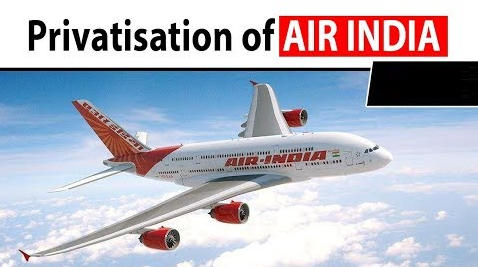Table of Contents
Q.) With reference to ‘National Investment and Infrastructure Fund’, which of the following statements is/are correct?
- It is an organ of NITI Aayog.
- It has a corpus of Rs. 4, 00,000 crore at present.
Select the correct answer using the code given below:
(a) 1 only
(b) 2 only
(c) Both 1 and 2
(d) Neither 1 nor 2


- The government in its latest move has set up a disinvestment panel which will work out modalities for the sale of the airline.
- This panel will be headed byHome Minister Amit Shah along with Finance Minister Nirmala Sitharaman, Civil Aviation Minister Hardeep Singh Puri and Railway Minister Piyush Goyal.
- The panel is called ‘Air India Specific Alternative Mechanism’ (AISAM)
- Finance Minister Nirmala Sitharaman in her maiden Budget Speech on July 5 had said that the government may sell 100 per cent stakes and aims to conclude the disinvestment process by the end of this year.

WHY IN NEWS?
- In the wake of its proposed privatisation, the government has asked Air India to put a freeze on large-scale promotion and appointments.
- A new flight has to be started only when it is extremely necessary and after due diligence from commercial aspect.
- “The direction says that due to impending privatization, no major initiatives have to be taken up. There will be freeze on appointments and promotions,” an official source told IANS.
- “Left to myself, I would all be interested entirely in supporting the public sector. But, the question arises: is the government equipped to run an entity, like Air India, where operational decisions on a day to day basis have to be taken on the spot?” Puri said in the Rajya Sabha.


WHAT IS THE DIFFERENCE BETWEEN DISINVESTMENT, STRATEGIC DISINVESTMENT AND PRIVATIZATION?
- In case of disinvestment, the Govt. sells share of a company for small volume (not below 51%) so that, control & management of company remains with the govt. itself.
- But strategic disinvestment involves sale of substantial volume of shares (below 51%) so that, part of the control of the company and management passes to the private shareholder.
- The strategic disinvestment fetches better price.
- But Disinvestment may or may not result in
Privatisation.
- When the Government retains 26% of the shares carrying voting powers while selling the remaining to a strategic buyer, it would have disinvested all right but would not have privatised, because with 26 per cent it can stall vital decisions for which generally a special resolution (three-fourths majority) is required.
TIMELINE
- In 2000-01 attempts were made to privatize Air India.
- In 2007, Air India and Indian Airlines were merged under Air India Limited.
- By March 2011, Air India had accumulated a debt of 426 billion and was seeking 429 billion from the government.
- The then-Civil Aviation Minister Ajit Singh in 2013 stated that privatization was the key to the airline’s survival.
- The Economic Survey 2017 recommended the government to privatize Air India.
- The state-owned airline had a debt of about Rs50, 000 crore.
- In 2017, the Narendra Modi government decided to privatize Air India.
- The government announced on May 31, 2018 that at the end of the deadline for submitting Expressions of Interest (EoIs), it had received no bids from any entity to acquire 76% stake in Air India.
- IndiGo announced it was pulling out of the race because the government’s plans for disinvestment did not suit its own, and it didn’t “have the capability to take on the task of acquiring and successfully turning around all of Air India’s airline operations”.
- EY prepared a report stating what could have been the probable reasons for the failure of the process.
- The government retaining 24 per cent stake
- Volatile crude oil prices
- Fluctuations in the exchange rate
- High debt
- Changes in macro environment
- Restriction on bidding by individuals.
WHY THERE IS NEED FOR PRIVATIZATION OF AIR INDIA?
- Air India is a fine example that could possibly go wrong with a public sector company.
- It is operationally inefficient and unable to compete with private sector operators.
- The government will have to keep bailing out Air India with taxpayers’ money if it decides to hold on to it.
- Market economy norm says that, the government should not be in the business of providing goods and services where the private sector has a vibrant presence.
- Air India presence is distorting the market. It has no fear of failing.
- This will also set an example and pave the way for disinvestment of other loss-making companies.

WAY FORWARD
- The government should work with professionals and investment bankers to find ways and make the deal reasonably attractive for a prospective buyer.
- The government can possibly sell the non-core assets that will help in bringing down the level of debt.
- Also, one last time government can infuse equity capital to bring down the debt and make it attractive for potential buyers.
- Government could also invite International Airlines for bidding.
Q.) With reference to ‘National Investment and Infrastructure Fund’, which of the following statements is/are correct?
- It is an organ of NITI Aayog.
- It has a corpus of Rs. 4, 00,000 crore at present.
Select the correct answer using the code given below:
(a) 1 only
(b) 2 only
(c) Both 1 and 2
(d) Neither 1 nor 2
Latest Burning Issues | Free PDF























 WhatsApp
WhatsApp